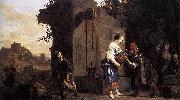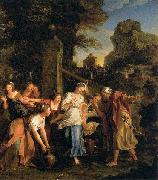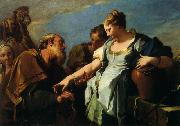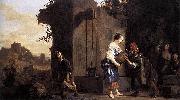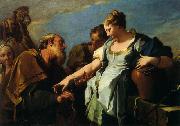Wholesale Oil Painting Reproductions No Minimum and Door to Door! |
|||||||||||
|
|
|||||||||||

|
|||||||||||
|
|
|
||||||||
All Salomon de Bray Oil Paintings |
||||||||
|
|
||||||||
|
|
||||||||
|
Artist Introduction: (Amsterdam, 1597 - Haarlem, 11 May 1664) was a Dutch Golden Age architect and painter.
De Bray established himself in Haarlem before 1617, where he is registered as being a member of the schutterij that year in the St. Adrian's cloveniers.[1] He probably followed draftsmanship and painting lessons in the small academy started by Karel van Mander, Hendrick Goltzius and Cornelis van Haarlem, and where he married in 1625. He is registered as a pupil of Goltzius and Cornelis van Haarlem, but he probably started his training in Amsterdam with Jan Pynas, Nicolaes Moeyaert and Pieter Lastman.He painted history paintings, portraits and landscapes. As a Catholic he probably also made altar pieces for the Haarlem underground Catholic churches known as mission stations, or staties. He was a member of the Chamber of rhetoric called "De Wijngaertranken". This is probably how he met his wife Anna, the sister of the painter Jan and the poet Jacob Westerbaen. They married in 1625 and in 1630 he became a member of the Haarlem Guild of St. Luke. He cooperated with fellow Haarlem lukasguild member Jacob van Campen in the decoration of Huis ten Bosch in The Hague. His works draw on the spirit of the Dutch classicism beginning at that time, and are comparable with those of Pieter de Grebber.
Transcription of Salomon de Bray's proposed hierarchy of the guild in 1631. The Haarlem archivist C.J. Gonnet published a book in 1877 on the Haarlem St. Lukasgilde archives. This was meant for historians wishing to do research on Haarlem painting, but who could not read the old handwriting.De Bray was also active as a designer of silverwork, as a poet, as an architect and as a town planner for the city council of Haarlem. He designed an ambitious plan to expand the city on the North side that was partially implemented in the decades after his death. He became headman of the Guild of St. Luke and even prepared a new charter for the guild (that was never ratified) in 1631. As an architect, he was involved in the construction or expansion of Haarlem's City Hall, Zijlpoort, and St. Annakerk (Church of St. Anne), and Nijmegen's city orphanage. One of his poems was set to music by his friend the composer Cornelis Padbru??.
Salomon de Bray was the father of ten children, of whom three (Dirck de Bray, Jan de Bray, and Joseph de Bray) became notable artists. He probably died of the plague that hit Haarlem in 1664, as he and his children Jacob, Josef, Juliana and Margaretha all died in April and May of that year. His wife had already died the previous year. He was buried in the Sint-Bavokerk in Haarlem.
In 1631 Salomon de Bray wrote "Architectura Moderna" which provided a biography and descriptions of buildings built by Hendrick de Keyser, one of the key Dutch architects of the period
|
||||||||
|
|
||||||||
|
Eliezer and Rebecca Painting ID:: 71010 |
1660(1660)
Oil on canvas
90 x 156 cm (35.43 x 61.42 in)
|
|||||||
Height Width |
INS/CM Quality |
|||||||
|
X |
| |||||||
|
|
||||||||
All Antoine Coypel Oil Paintings |
||||||||
|
|
||||||||
|
|
||||||||
|
Artist Introduction: 1661-1722
French
Antoine Coypel Location
Antoine studied at the Coll?ge d Harcourt and then trained in his father studio and at the Academie Royale. In 1672 No Coypel was made Director of the Academie de France in Rome, and Antoine, who accompanied his father to Italy, benefited from the education given to the students there. He also joined in their long sessions spent copying Raphael frescoes in the Vatican Loggie and the works of the Carracci and Domenichino in the Palazzo Farnese. He met Giovanni Lorenzo Bernini and Carlo Maratti and was awarded a drawing prize by the Accademia di S Luca. During his return journey Antoine stopped in northern Italy to study the works of Correggio |
||||||||
|
|
||||||||
|
|
Eliezer and Rebecca Painting ID:: 71432 |
Date 1701(1701)
Medium Oil on canvas
Dimensions 125 x 106 cm (49.21 x 41.73 in)
|
||||||
Height Width |
INS/CM Quality |
|||||||
|
X |
| |||||||
|
|
||||||||
All Giambattista Pittoni Oil Paintings |
||||||||
|
|
||||||||
|
|
||||||||
|
Artist Introduction: (1687?C1767) was an Italian painter of the late-Baroque or Rococo period, active mainly in his native Venice.
Pittoni is best known for his "grand-manner" canvases depicting religious, historical, and mythological subjects (such as Sophonisba and Polyxena). He was a co-founder of the official painter's academy in Venice (in competition to the old fraglia or painter's guild), the Accademia di Belle Arti di Venezia, and he succeeded as President (1758?C1761) his contemporary Giovanni Battista Tiepolo. Pittoni never left his native Venice, but completed commissions from German, Polish, Russian, and Austrian patrons. His mature palette was noted, as was Tiepolo's, for his lightness of tone. Besides Tiepolo, Pittoni's influences were Giovanni Battista Piazzetta, Sebastiano Ricci, and Antonio Balestra. His paintings were of a Rococo style, but later became more sedate in their approach towards Neoclassicism.
|
||||||||
|
|
||||||||
|
|
Eliezer and Rebecca Painting ID:: 71903 |
18th century
Oil on canvas
168 x 130 cm (66.14 x 51.18 in)
|
||||||
Height Width |
INS/CM Quality |
|||||||
|
X |
| |||||||
|
|
||||||||
All BRAY, Salomon de Oil Paintings |
||||||||
|
|
||||||||
|
|
||||||||
|
Artist Introduction: Dutch Baroque Era Painter, 1597-1664
De Bray established himself in Haarlem before 1617, where he is supposed to have been taught by Hendrick Goltzius and Cornelis van Haarlem, and where he married in 1625. He painted history paintings, portraits and landscapes. As a Catholic he probably also made altar pieces for clandestine churches. He cooperated in the decoration of Huis ten Bosch in The Hague. His works draw on the spirit of the Dutch classicism beginning at that time, and are comparable with those of Pieter de Grebber.
De Bray was also active as a designer of silverwork, as a poet, as an architect and as a town planner. As an architect, he was involved in the construction or expansion of Haarlem's City Hall, Zijlpoort, and St. Annakerk (Church of St. Anne), and Nijmegen's city orphanage. One of his poems was set to music by his friend the composer Cornelis Padbru??.
Salomon de Bray was the father of ten children, of whom three (including Jan de Bray) became artists. He probably died of the plague, as some of his children and was buried in the Sint-Bavokerk in Haarlem. |
||||||||
|
|
||||||||
|
|
Eliezer and Rebecca Painting ID:: 72669 |
Date 1660(1660)
Medium Oil on canvas
Dimensions 90 X 156 cm (35.43 X 61.42 in)
cyf |
||||||
Height Width |
INS/CM Quality |
|||||||
|
X |
| |||||||
|
|
||||||||
All Giambattista Pittoni Oil Paintings |
||||||||
|
|
||||||||
|
|
||||||||
|
Artist Introduction: (1687?C1767) was an Italian painter of the late-Baroque or Rococo period, active mainly in his native Venice.
Pittoni is best known for his "grand-manner" canvases depicting religious, historical, and mythological subjects (such as Sophonisba and Polyxena). He was a co-founder of the official painter's academy in Venice (in competition to the old fraglia or painter's guild), the Accademia di Belle Arti di Venezia, and he succeeded as President (1758?C1761) his contemporary Giovanni Battista Tiepolo. Pittoni never left his native Venice, but completed commissions from German, Polish, Russian, and Austrian patrons. His mature palette was noted, as was Tiepolo's, for his lightness of tone. Besides Tiepolo, Pittoni's influences were Giovanni Battista Piazzetta, Sebastiano Ricci, and Antonio Balestra. His paintings were of a Rococo style, but later became more sedate in their approach towards Neoclassicism.
|
||||||||
|
|
||||||||
|
|
Eliezer and Rebecca Painting ID:: 73180 |
Date 18th century
Medium Oil on canvas
Dimensions 168 X 130 cm (66.14 X 51.18 in)
cyf
|
||||||
Height Width |
INS/CM Quality |
|||||||
|
X |
| |||||||
|
|
||||||||
|
Prev Next
|
||||||||
|
|
||||||||
|
Related Paintings to Giambattista Pittoni :. |
||||||||
|
|
||||||||
|
CONTACT US |
